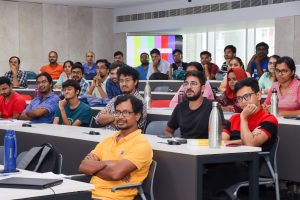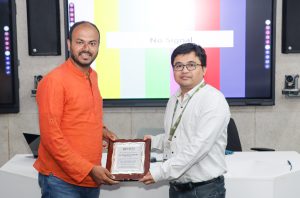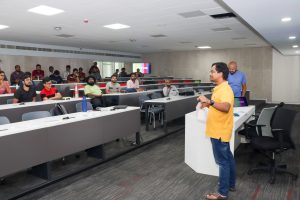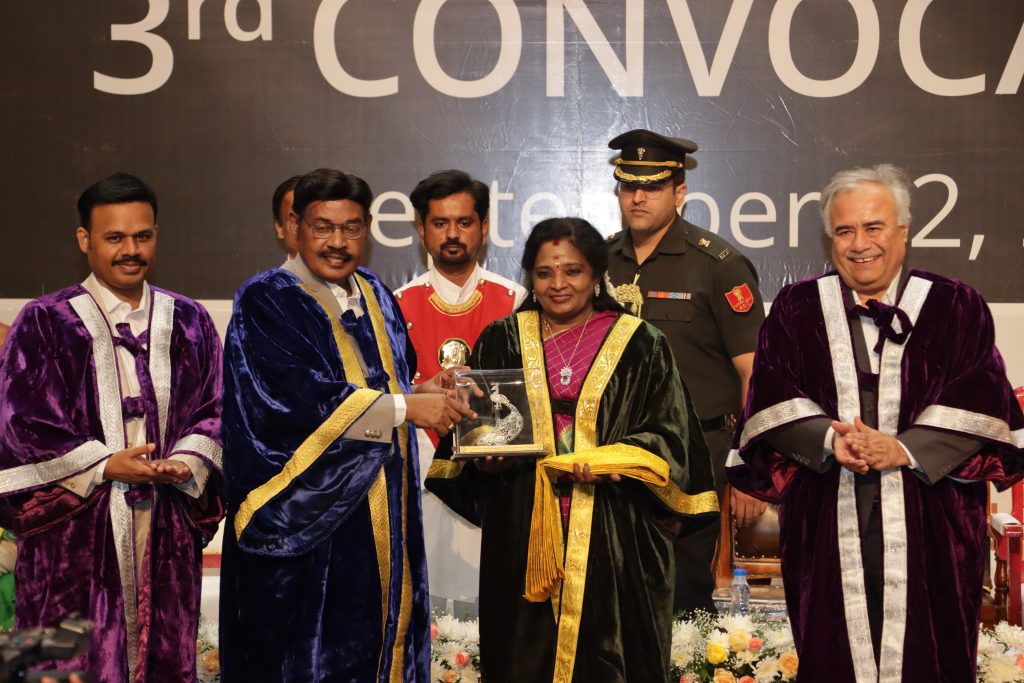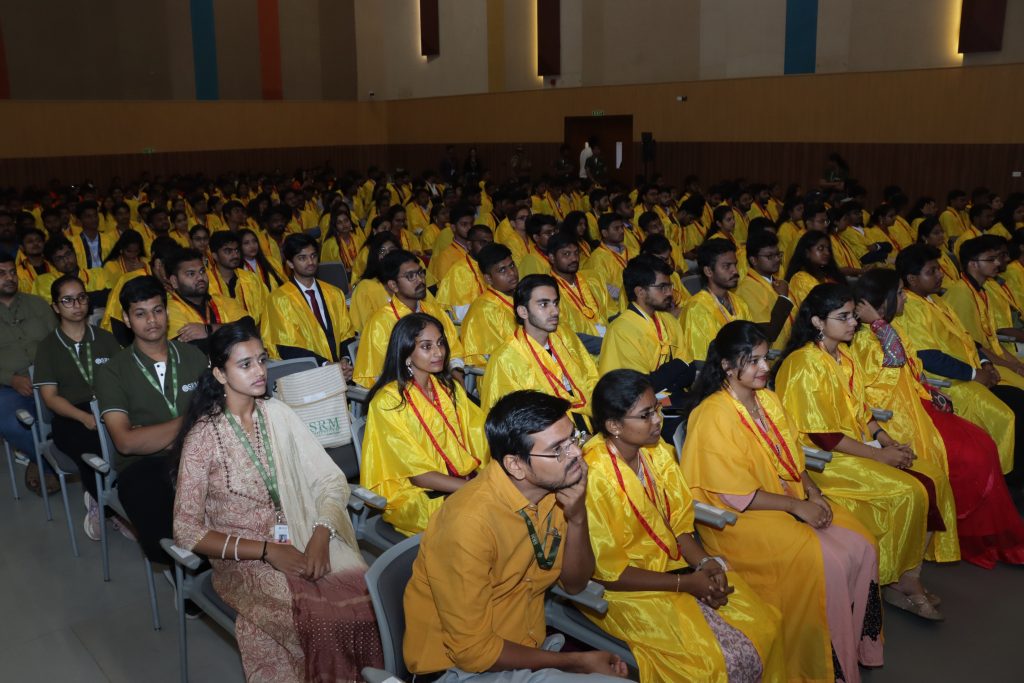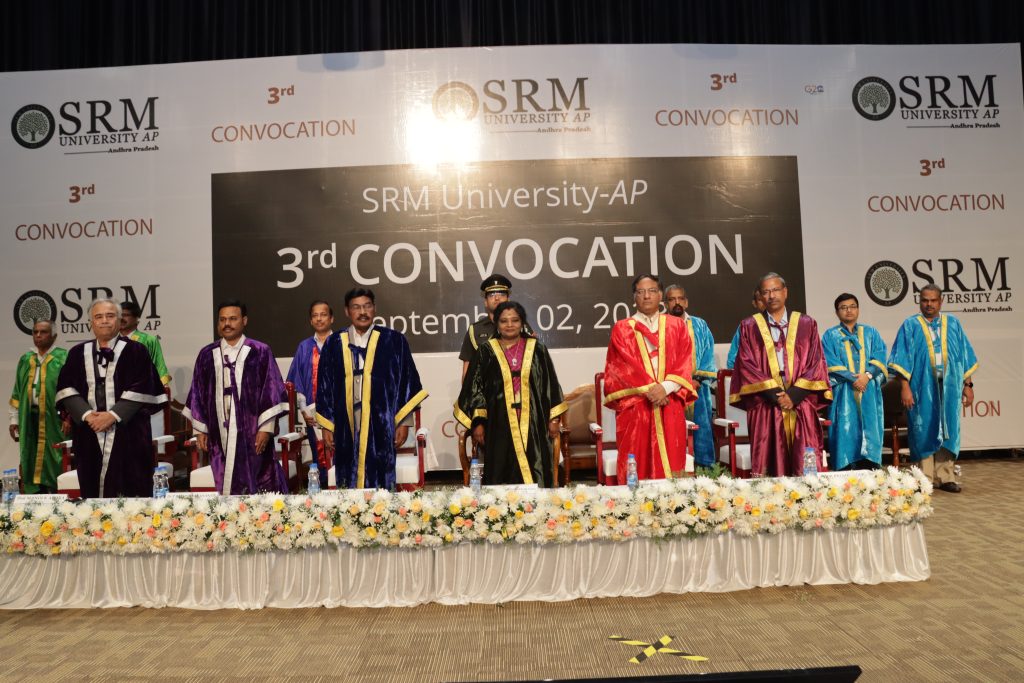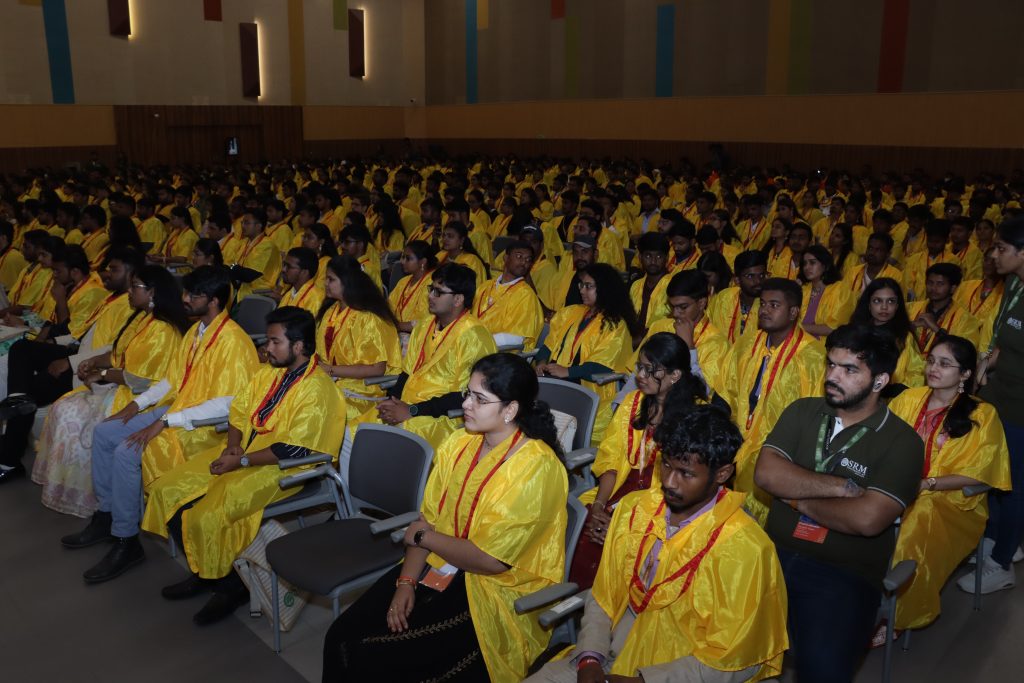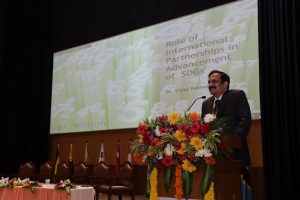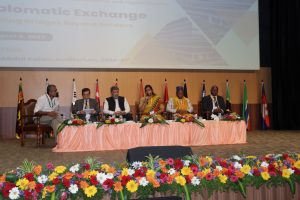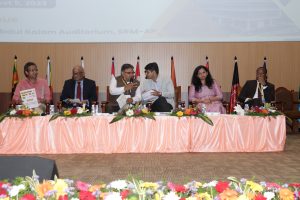SRM University-AP hosted AIS School on p-adic methods in Arithmetic
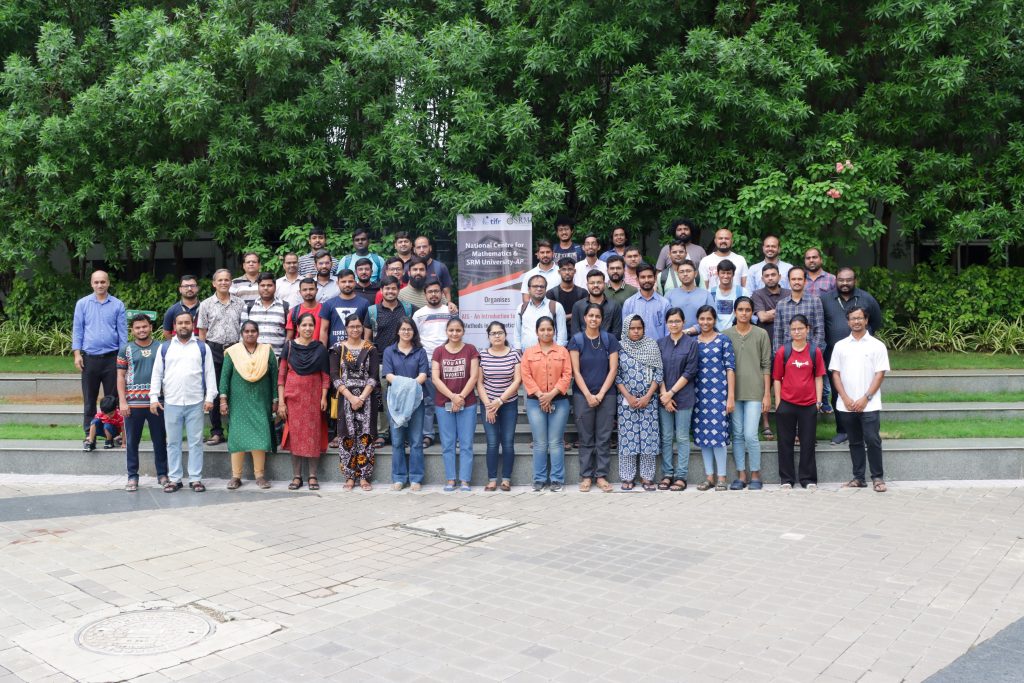
The Department of Mathematics, in collaboration with the National Centre for Mathematics, organised an AIS school on p-adic methods in Arithmetic from June 26 to July 15, 2023 at the campus. Over 58 students, research scholars, post-doc fellows and faculty from reputed universities such as IIT Hyderabad, IIT Guwahati, IISER, University of Hyderabad, Pondicherry University, Banaras Hindu University etc. participated in the three-week-long AIS school, which was conducted with the prime objective to study the p-adic numbers and the p-adic methods in arithmetic.
Prof. C S Rajan, Ashoka University; Dr Manish Kumar Pandey and Dr Sazzad Ali Biswas, SRM University-AP; Dr Amiya Kumar Mondal, IISER Berhampur; Dr Santosh Nadimpalli, IIT Kanpur; Dr Shaunak Deo, IISc, Bangalore; and Dr Mihir Sheth, Post-Doc, IISc, Bangalore were the speakers at the school. The sessions were delivered in collaboration with course associates /tutors. Dr Arindam Jana, Postdoc, TIFR Mumbai; Dr Ravitheja Vangola, Postdoc, IISC Bangalore; Mr Sagar Shrivastava, Mr Manodeep Raha, and Mr Niladri Sekhar Patra, PhD scholar, TIFR Mumbai were the tutors mentoring the participants.
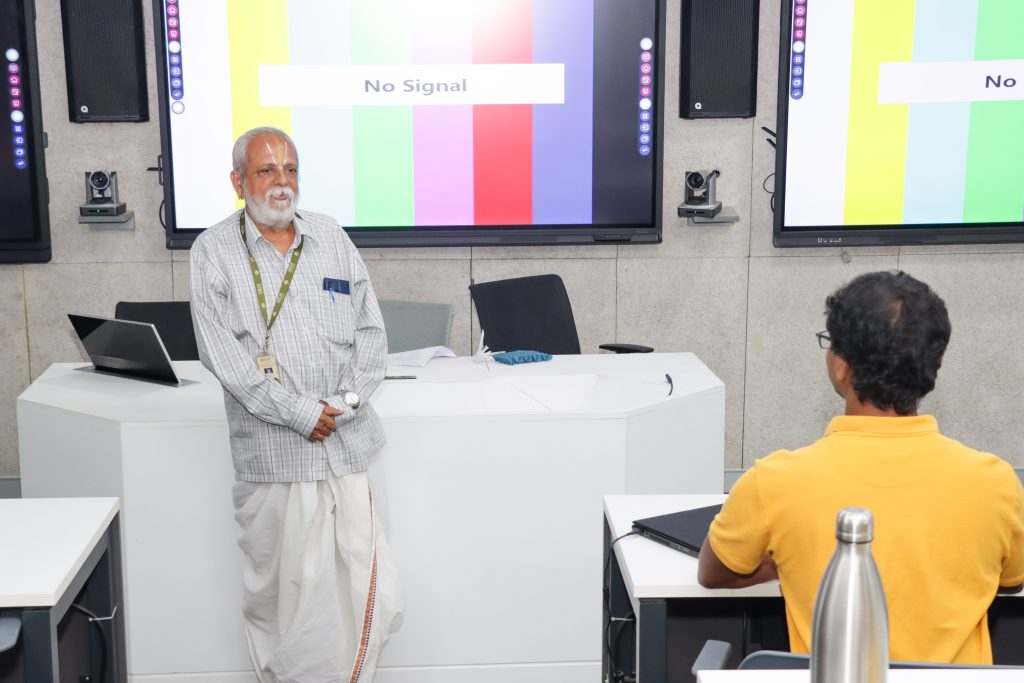
Prof. C S Rajan delivered 9 lectures – four lectures in the first week of the programme and five lectures at the end of the programme. The first part of his session covered topics such as Hensel’s Lemma and Local-Global Principle while the latter part focused on the Main Conjecture of Iwasawa Theory and Introduction to the work of Ribet (Converse to Herbrand) and subsequent work.
Dr Sazzad Ali Biswas offered his insights on topics like Construction of p-adic numbers, Various Properties (algebraic and Analytic) of p-adic numbers, Arithmetic operations of p-adic numbers and Local-Global Principle in five sessions. Dr Manish Kumar Pandey gave two lectures on the Special values of the Riemann zeta functions.
Local Fields, Global Fields and p-adic algebraic numbers were the focal points of the four lectures delivered by Dr Mihir Sheth. Dr Amiya Kumar Mondal took five lectures on Modular Forms and Dr Santosh Nadimpally gave five lectures on the Construction of p-adic zeta functions and the Various properties of p-adic Zeta function. Dr Shaunak Deo dealt with topics including Cyclotomic Fields, Iwasawa’s Construction of p-adic L-fucntions and p-adic Family of Modular Forms through six lectures.
The AIS School was organised by Prof. C S Rajan of Ashoka University and Assistant Professors Dr Manish Kumar Pandey and Dr Sazzad Ali Biswas of the Department of Mathematics at SRM University-AP. The programme successfully concluded with the active participation of students, scholars and faculty who assembled to exchange constructive discourse on p-adic methods in Arithmartics.
- Published in Departmental News, Math News, News
Hon’ble Governor of Telangana Felicitates Graduates at the 3rd Convocation Ceremony
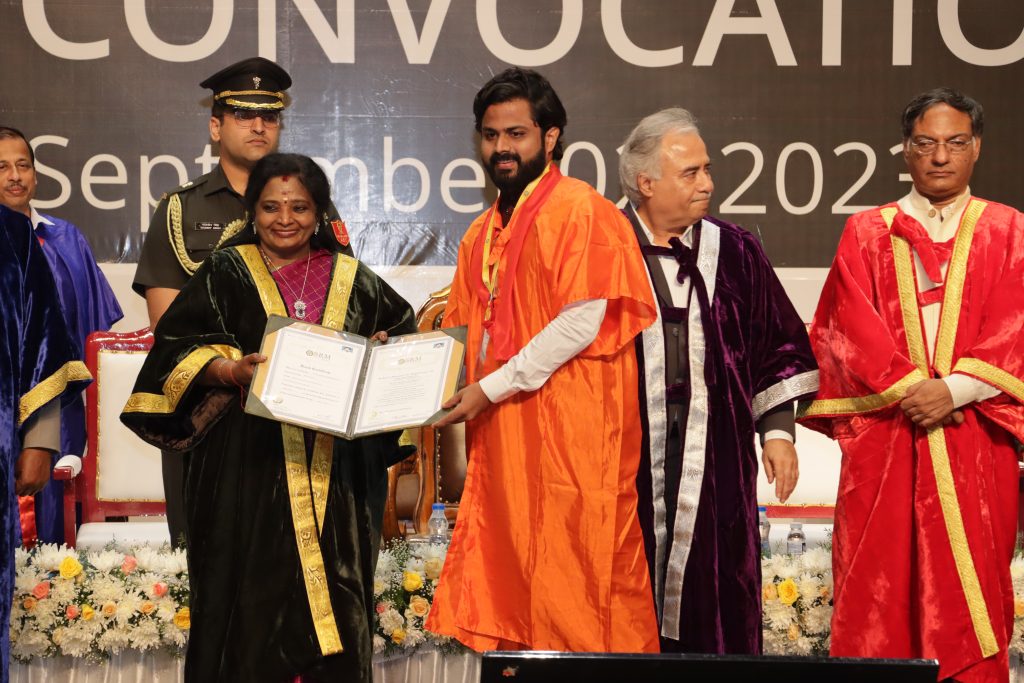
“Education provides you confidence. Sharpen your skills each passing day and visualise the development of your nation. Learn more than expected and earn more than expected is the ideology that we live by today”, Her Excellency Dr Tamilisai Soundararajan, Hon’ble Governor of Telangana, the chief guest of the 3rd Convocation Ceremony of SRM University-AP remarked while addressing the graduating Class of 2023.
The university has conferred the prestigious degrees to the Graduate Class of 2023 at the 3rd Convocation Ceremony on September 02, 2023, in the august presence of Guest of Honour, Prof. Ashutosh Sharma, President-Indian National Science Academy; Dr T R Paarivendhar, Founder Chancellor, SRM Group of Institutions; Dr P Sathyanarayanan, Pro-Chancellor; Prof. Manoj K Arora, Vice Chancellor, SRM University-AP; Other dignitaries; Deans of all schools, faculty, staff and parents of the graduating batch. A remarkable 883 graduates, including 13 PhD scholars, 17 Gold medallists, 6 Silver medallists and 2 Bronze medallists were awarded their degrees at the momentous ceremony held at the APJ Abdul Kalam Auditorium.
“In our objective of being globally connected, nationally relevant and regionally transformative university, we have adopted a five-year strategic plan with five goals – Achieve academic excellence, Intensify research, innovation and entrepreneurial spirit, Enhance student experience, Attain financial sustainability and Improve perception and visibility”, stated Vice Chancellor, Prof. Manoj K Arora in his welcome address. During his briefing about the annual report, Prof. Arora also highlighted the placements excellence of the past academic year. He commented, “In the last academic year, we have witnessed 100% placements with the highest package being 45 LPA and average salary of 9 LPA which is a 25% increase from last year. 15 students have received international offers from countries such as USA, Australia, Japan, Sweden etc. As we host the 3 rd convocation of the institute, we are proud to say we are a young university with 1500 alumni, of which 34% of them are working in Fortune 500 companies, 17% are studying abroad, 7 have their own startups.”
Founder Chancellor, Dr T R Paarivendhar, in his address to the young graduates, commented that India’s first solar launch, Aditya L1 and our country’s presidency over the G20 summit coincided with the students’ graduation and encouraged them to strive for excellence with love for family, their alma mater and country in their hearts. “Success in life needs to be balanced with philosophy and spirituality. SRM University-AP has prepared you for the transition of student to alumni, by imparting knowledge and the skill to learning how to learn. Use the skills you have acquired to pursue prosperity and contribute to the growth of society”, advised Pro-Chancellor, Dr P Sathyanarayanan on this milestone event.
The university also conferred an Honorary Doctorate to Prof. Ashutosh Sharma, esteemed Guest of Honour by the Founder Chancellor, Dr T R Paarivendhar and Hon’ble Governor for his exemplary contributions to the field of sciences. “Success and inclusive development is going to be a global challenge. As we continue to progress at an unprecedented pace, remember that new knowledge is no knowledge without using it for socio-economic good” stated Prof. Sharma in his address. He deeply appreciated how research is ingrained into the very fabric of the varsity’s educational approach assuring research opportunities to the young researchers of our country.
The convocation ceremony successfully concluded with the administration of the pledge by the graduation cohort, honouring the national anthem and the departure of the dignitaries.
- Published in News, University Event
Follow your Passion or Profession: Ms Ramya Proves Why Not Both!
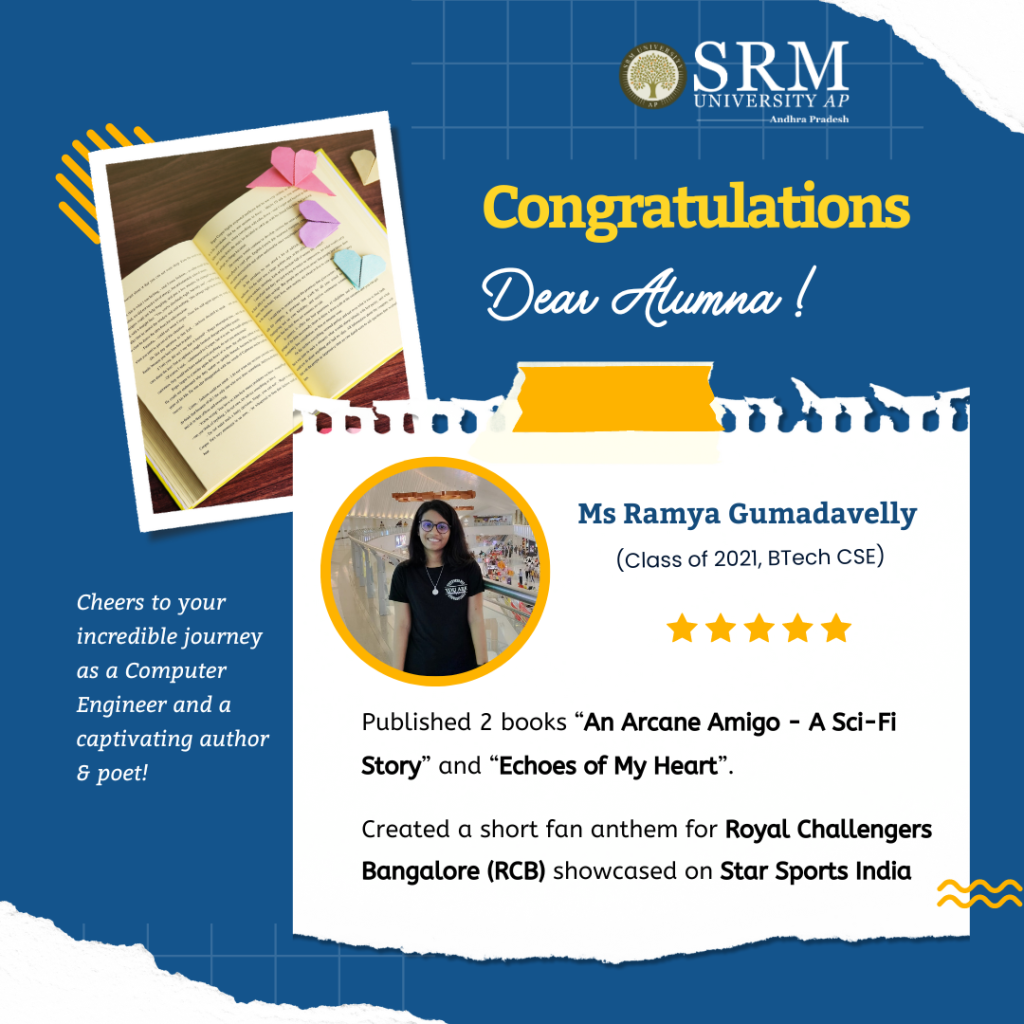
“Happiness lies in the joy of achievement and the thrill of creative effort” said Franklin D Roosevelt. The Directorate of Alumni Relations proudly announce that our dear alumna, Ms Ramya Gumadavelly (Class of 2021 BTech CSE) has manifested the saying with her remarkable achievement of publishing two captivating books “An Arcane Amigo – A Sci-Fi Story” and “Echoes of My Heart”. Her third book “Who in the World Am I?”, awaiting release, undoubtedly promises to be another milestone in her literary journey!
Her works, including a short fan anthem for Royal Challengers Bangalore (RCB) and several poems dedicated to her favourite cricketer Virat Kohli, have been showcased on Star Sports India for the last IPL season!
Congratulations to Ms Ramya for her remarkable achievement! Being a Computer Engineer by profession did not stop our talented alumna from pursuing her passion for literature and poetry!
Click to check out her published works:-
An Arcane Amigo – https://amzn.eu/d/d0nSO3F
Echoes of My Heart – https://amzn.eu/d/ds9UXVe
- Published in Alumni, Alumni Relations News, Departmental News, News
“Diplomatic Exchange: Building Bridges Beyond Borders”- SRM University-AP hosts Diplomats from over 13 Countries
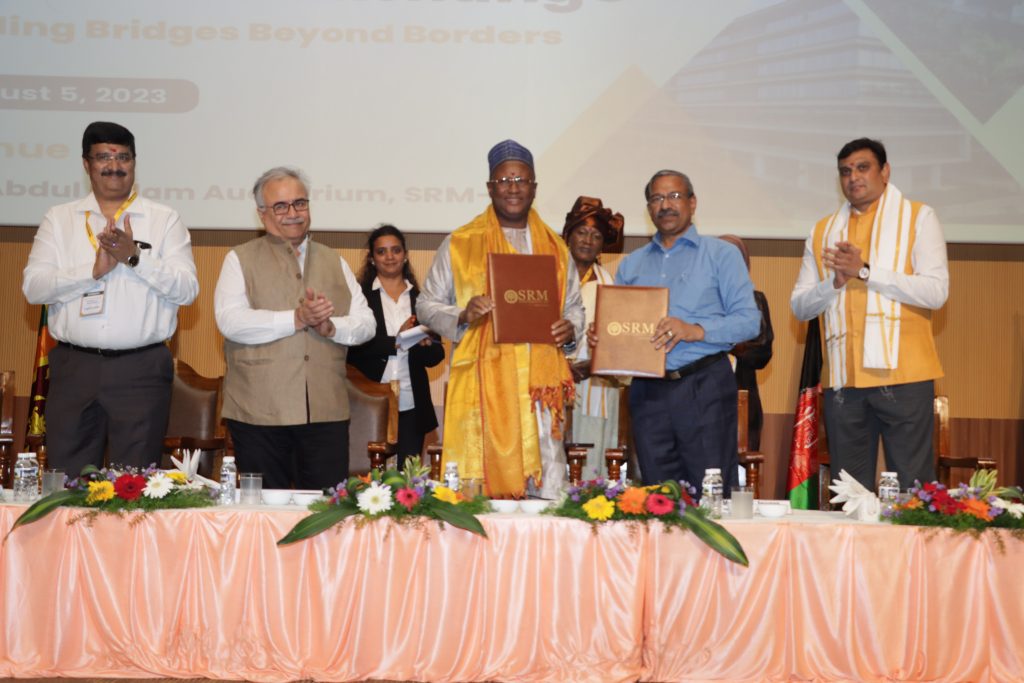
SRM University-AP organised an exclusive gathering of diplomats, academicians, and policy leaders from across the globe at the “Diplomatic Exchange: Building Bridges Beyond Borders” on August 05, 2023, to foster meaningful interactions, cultural exchange, and the establishment of strong global partnerships. The event was inaugurated with an auspicious lamp-lighting ceremony by H. E Mustapha Jawara, High Commissioner, High Commission – Republic of Gambia; Amb. Rtn. Anil Trigunayat (IFS Retd.), Chairman-Confederation of Education Excellence, Dr Harsha Bhargavi Pandiri, Assistant Director, Public Relations-Ministry of Culture, in the presence of Prof. Manoj K Arora, Honourable Vice Chancellor, SRM AP and Dr R Premkumar, Registrar; SRM AP. “We have had a long bilateral relationship with India for years, and we would like to continue to strengthen this camaraderie”, said H. E. Mustapha Jawara, Gambian High Commissioner while signing an MOU with SRM University-AP. Delegates and diplomats from over 13 countries gathered at the International Diplomat Meet.
“We are at an interesting phase in the global domain where India is emerging as an economic power and central contributor to the world. We are actively promoting the G20 initiative to achieve ‘One World, One Family’ and bridge the gap with the outside world through connection, coordination and cooperation”, commented Prof. Manoj K Arora, Vice Chancellor, SRM University-AP while addressing the delegates from various countries.
Chief Guest of the event, Prof. K Hemachandra Reddy, Andhra Pradesh State Council for Higher Education (APSCHE), praised the university on its flagship initiative. “An ancient Indian philosophy narrates that a student in pursuit of knowledge will acquire knowledge through four stages – 25% from teachers, 25% through curiosity, 25% from peers and 25% with time and experience.” This can be implemented in global education where a diversified academic pool will enhance the strength of our national education and youth. SRM University-AP has manifested this by establishing and building networks extending beyond state and national boundaries.”
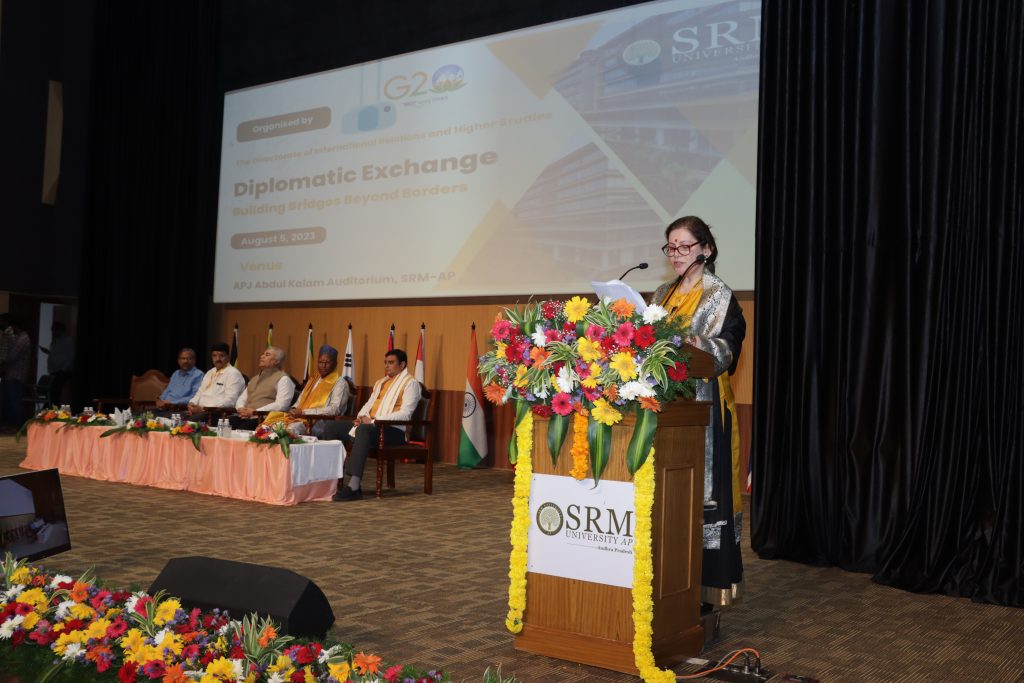
The Exchange emphasised the relevance of digital diplomacy in the postmodern political milieu. “With the strategic shift in the global world, India plays a pivotal role in leading the G20 summit. We as a nation recognise the power of digital diplomacy in crisis management and conflict resolutions in issues of national and international significance and promote digital diplomacy as an essential competency for diplomats in the 21st century”, commented Guest of Honour, Shri. P Samuel Jonathan, Andhra Pradesh State Information Commissioner.
Panel discussions on enhancing diplomatic relations through academic exchange, discourses on advancements of SDGs through international partnerships, and Press Meet were the highlights of the Diplomatic Exchange. Mr Suresh Chukkapalli, Consul General, Honorary Consulate of the Republic of Korea, suggested that countries like Taiwan and Japan have low populations and require India to provide a highly skilled workforce to their employment sector during the press meet. He enlightened the gathering on the high scope for employability in Asian countries and suggested the inclusion of academic and linguistic programmes at SRM university-AP to enhance the skill set of students.
The Diplomatic Exchange was marshalled under the aegis of the Directorate of International Relations and Higher Studies and Dr Naga Swetha Pasupuleti, Director-IR & HS, to promote constructive diplomatic connections between the leadership of various countries promoting global partnerships. The Meet sought to provide future leaders with an in-depth knowledge of diplomatic relations, digital diplomacy, and countries working towards ‘One World, One Earth, One Family’ by means of cross-cultural education.
- Published in International Relations, IR-News, News
AKAP-IoV: Facilitating an intelligent transportation infrastructure
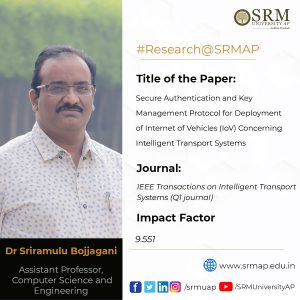 Intelligent transport systems embedded with latest technology is the future of automotive industry and can revolutionise the very infrastructure and architecture of transportation. The principles of intelligent transportation systems have manifested in the development of Internet of vehicles (IoV), a novel technological network that enables autonomous and connected mobile commutation facility. Dr Sriramulu Bojjagani, Assistant Professor, Department of Computer Science and Engineering, has published a paper on this seminal topic titled “Secure Authentication and Key Management Protocol for Deployment of Internet of Vehicles (IoV) Concerning Intelligent Transport Systems” in the prestigious journal, IEEE Transactions on Intelligent Transport Systems (Q1 journal) having an Impact factor of 9.551. The paper highlights the development and significance of the pioneering AKAP-IoV system in successfully tackling cyber threats and security vulnerabilities.
Intelligent transport systems embedded with latest technology is the future of automotive industry and can revolutionise the very infrastructure and architecture of transportation. The principles of intelligent transportation systems have manifested in the development of Internet of vehicles (IoV), a novel technological network that enables autonomous and connected mobile commutation facility. Dr Sriramulu Bojjagani, Assistant Professor, Department of Computer Science and Engineering, has published a paper on this seminal topic titled “Secure Authentication and Key Management Protocol for Deployment of Internet of Vehicles (IoV) Concerning Intelligent Transport Systems” in the prestigious journal, IEEE Transactions on Intelligent Transport Systems (Q1 journal) having an Impact factor of 9.551. The paper highlights the development and significance of the pioneering AKAP-IoV system in successfully tackling cyber threats and security vulnerabilities.
Abstract
Intelligent transport systems amalgamated with advanced technologies are an important element of the automotive industry, including critical infrastructure and transportation. Internet of Vehicles (IoV) is the modern technological framework designed for intelligent transportation. IoV creates a network of information relations among vehicles, thus contributing to reduced congestion, roadside infrastructure, driver/traveller safety, and traffic efficiency through wireless communication and sensing technology. However, a significant challenge in IoV applications is security, as criminals could potentially exploit these applications. Despite increasing industry awareness, the potential danger posed by security vulnerabilities and cyber threats remains high. In this study, we have designed a new system called AKAP-IoV, which supports secure communication, mutual authentication, and key management among vehicles, roadside units, and fog and cloud servers. AKAP-IoV was tested and verified using Scyther and Tamarin to ensure its resistance to cyber threats. Furthermore, we conducted a formal security analysis using the Real-or-Random (RoR) oracle model to assess security properties logically. In addition, a detailed, comprehensive comparative study was considered to evaluate the performance, functionality, efficiency, and security features supported by AKAP-IoV compared to those of recently developed schemes.
- Published in CSE NEWS, Departmental News, News, Research News
‘The modern Kautilya of India’: Dr C Rangarajan on India’s economic development
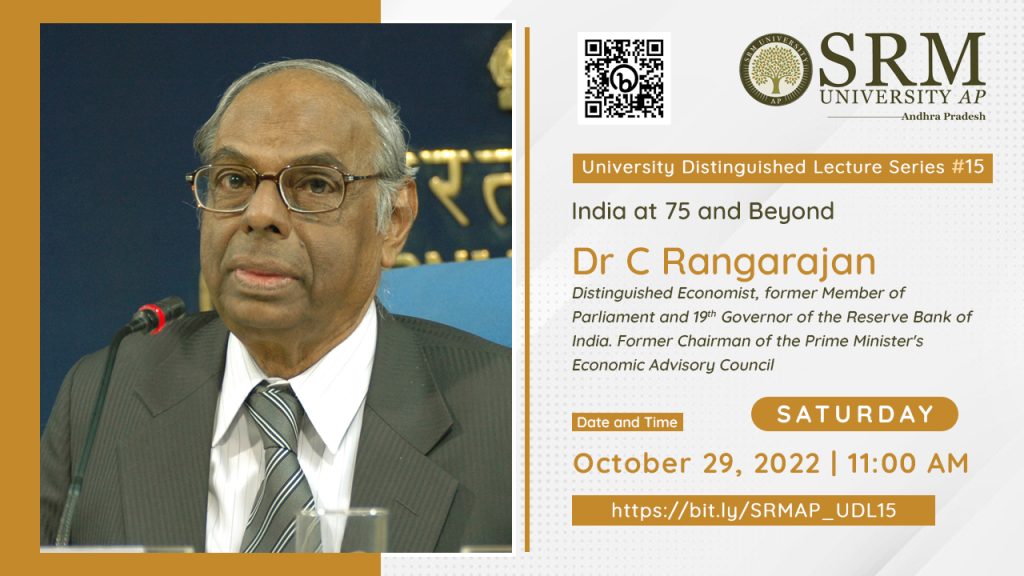 The fifteenth edition of University Distinguished Lecture series on the topic “India at 75 and beyond”, was held on October 29, 2022 to celebrate the magnificent growth displayed by India. The session was addressed by Dr C Rangarajan, renowned economist and former Governor of Reserve Bank of India. The intense and inspiring lecture highlighted the importance of reflection on the past and articulation of our vision for our future to enable rapid progression on economic development.
The fifteenth edition of University Distinguished Lecture series on the topic “India at 75 and beyond”, was held on October 29, 2022 to celebrate the magnificent growth displayed by India. The session was addressed by Dr C Rangarajan, renowned economist and former Governor of Reserve Bank of India. The intense and inspiring lecture highlighted the importance of reflection on the past and articulation of our vision for our future to enable rapid progression on economic development.
Dr C Rangarajan gave a comprehensive outlook on the economic performance of India since independence. “India has made momentous progress on reducing multidimensional poverty. The incidents of multidimensional poverty were almost reduced by half to almost 27.5% during 2005-06 and 2015-16 period due to deeper progress among the poorest. Thus within 10 years, the number of poor people in India fell by more than 270 million, a truly massive achievement,” he stated during the lecture.
Dr Rangarajan further expounded on the importance of reform agendas and measures, the subsisting triad of economic policies and the future challenges of progressing into being a developed nation. The lecture was followed by a Q & A session moderated by Dr S Ananda Rao and Dr Erra Kamal Sai Sadharma from the Department Economics.
Prof Kamaiah Bandi, Dean-School of Liberal Arts and Social Sciences applauded Dr Rangarajan on being a unique distinction of shaping and motivating five generations of intellectual cohort. “Dr C Rangarajan has successfully brought down the gap between theory and practice in his capacity as Governor of RBI and various other important positions he has held for our nation. We as SRM AP look forward to your remarkable experience and knowledge to incubate motivation in our students.”
SRM University-AP has actively promoted a cumulative intellectual ecosystem and interdisciplinary education. “The principal objective of the University Distinguished Lecture series is to impel research scholars, students from all around the world to undertake progressive measures for the holistic development of our nation”, said Honourable Vice Chancellor, Prof Manoj K Arora in his welcome address.
Prof D Narayana Rao, Pro-Vice-Chancellor, SRM University-AP concluded the event by addressing Dr C Rangarajan as ‘the modern Kautilya of India’ and presented a memento on behalf of the institution as a token of respect and appreciation for his esteemed presence at the fifteenth edition of the University Distinguished Lecture series.
Doctoral scholar secures visiting fellowship
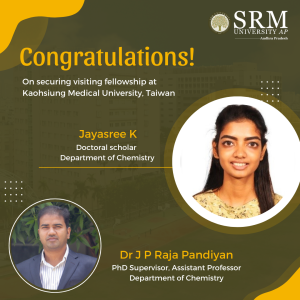
Exposure to international research opportunities promotes empirical learning at an impeccable level. International research ventures aid scholars to explore novel research avenues enabling a transformative progress for society through the field of science. The Department of Chemistry is glad to announce that Ms Jayasree K, PhD scholar, has been accepted for Short-Term Research Internship (STRI) for a period of six months from the Research Center of Environmental Medicine, Kaohsiung Medical University, Taiwan.
Ms Jayasree has been elevated in receiving the offer and delightfully keen on the new avenues she could explore through this opportunity. She is currently working in the field of surface-enhanced Raman spectroscopy (SERS). In this particular research area, her major research objective is the design and development of a novel SERS substrate for food and bioanalysis.
“My internship mentor, Prof. Vinoth Kumar, KMU University is an expert in mass spectroscopy and High-performance liquid chromatography (HPLC). Therefore, I have an option to hyphenate the Raman technique along with mass spectroscopy which leads Raman research to the next level for various applications”, commented Ms Jayasree on this incredible opportunity.
Her internship at Kaohsiung Medical University (KMU) is based on the motive of research on food and environmental toxicity which would provide guidance on her first research project in the field of food analysis.
She has offered her sincere gratitude to her supervisor, Dr Rajapandiyan JP, Department of Chemistry for his constant support and advice from the application process to proposal writing, experimental planning etc. She also thanked SRM University- AP in providing support through the process and extending travel allowance and guidance.
Ms Jayasree utilizes this great opportunity to explore and discover herself, developing both personally and professionally. Through this internship she hopes to learn new skills, expand her knowledge in the field of research and explore career options in Taiwan.
- Published in Chemistry-news, Departmental News, News, Students Achievements
Classification of brain tumours using fine tuned ensemble of ViTs
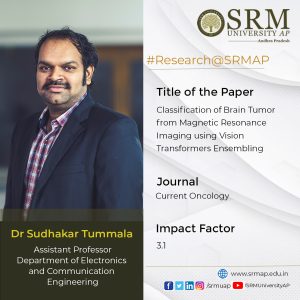
Primary brain tumours make up less than 2% of cancers and statistically occur in around 250,000 people a year globally. Medical resonance imaging (MRI) plays a pivotal role in the diagnosis of brain tumours and advanced imaging techniques can precisely detect brain tumours. On this note, Dr Sudhakar Tummala, Assistant Professor, Department of Electronics and Computer Engineering, has published a paper titled, “Classification of Brain Tumour from Magnetic Resonance Imaging using Vision Transformers Ensembling” in the journal Current Oncology having an impact factor of 3.1. The paper highlights the pioneering breakthrough made in the development of vision transformers (ViT) in enhancing MRI for efficient classification of brain tumours, thus reducing the burden on radiologists.
Abstract of the paper
The automated classification of brain tumours plays an important role in supporting radiologists in decision making. Recently, vision transformer (ViT)-based deep neural network architectures have gained attention in the computer vision research domain owing to the tremendous success of transformer models in natural language processing. Hence, in this study, the ability of an ensemble of standard ViT models for the diagnosis of brain tumours from T1-weighted (T1w) magnetic resonance imaging (MRI) is investigated. Pretrained and fine tuned ViT models (B/16, B/32, L/16, and L/32) on ImageNet were adopted for the classification task. A brain tumour dataset from figshare, consisting of 3064 T1w contrast-enhanced (CE) MRI slices with meningiomas, gliomas, and pituitary tumours, was used for the cross-validation and testing of the ensemble ViT model’s ability to perform a three-class classification task. The best individual model was L/32, with an overall test accuracy of 98.2% at 384 × 384 resolution. The ensemble of all four ViT models demonstrated an overall testing accuracy of 98.7% at the same resolution, outperforming individual model’s ability at both resolutions and their ensemble at 224 × 224 resolution. In conclusion, an ensemble of ViT models could be deployed for the computer-aided diagnosis of brain tumours based on T1w CE MRI, leading to radiologist relief.
A brief summary of the research in layperson’s terms
Brain tumours (BTs) are characterised by the abnormal growth of neural and glial cells. BTs causes several medical conditions, including the loss of sensation, hearing and vision problems, headaches, nausea, and seizures. There exist several types of brain tumours, and the most prevalent cases include meningiomas (originate from the membrane surrounding the brain), which are non-cancerous; gliomas (start from glial cells and the spinal cord); and glioblastomas (grow from the brain), which are cancerous. Sometimes, cancer can spread from other parts of the body, which is called brain metastasis. A pituitary tumour is another type of brain tumour that develops in the pituitary gland in the brain, and this gland primarily regulates other glands in the body. Magnetic resonance imaging (MRI) is a versatile imaging method that enables one to noninvasively visualise inside the body, and is in extensive use in the field of neuroimaging.
There exist several structural MRI protocols to visualise inside the brain, but the prime modalities include T1-weighted (T1w), T2-weighted, and T1w contrast-enhanced (CE) MRI. BTs appear with altered pixel intensity contrasts in structural MRI images compared with neighbouring normal tissues, enabling clinical radiologists to diagnose them. Several previous studies have attempted to automatically classify brain tumours using MRI images, starting with traditional machine learning classifiers, such as support vector machines (SVMs), k-nearest-neighbour (kNN), and Random Forest, from hand-crafted features of MRI slices. With the rise of convolutional neural network (CNN) deep learning model architectures since 2012, in addition to emerging advanced computational resources, such as GPUs and TPUs, during the past decade, several methods have been proposed for the classification of brain tumours based on the finetuning of the existing state-of-the-art CNN models, such as AlexNet, VGG16, ResNets, Inception, DenseNets, and Xception, which had already been found to be successful for various computer vision tasks.
Despite the tremendous success of CNNs, they generally have inductive biases, i.e., the translation equivariance of the local receptive field. Due to these inductive biases, CNN models have issues when learning long-range information; moreover, data augmentation is generally required for CNNs to improve their performance due to their dependency on local pixel variations during learning.Therefore, in this work, the ability of pretrained and fine tuned ViT models, both individually and in an ensemble manner, is evaluated for the classification of meningiomas, gliomas, and pituitary tumours from T1w CE MRI at both 224 × 224 and 384 × 384 image resolutions.
Dr Sudhakar Tummala has mentioned the social implications of the research by expounding that the computer-aided diagnosis of brain tumours from T1w CE MRI using an ensemble of fine tuned ViT models can be an alternative to manual diagnoses, thereby reducing the burden on clinical radiologists. He also explains the future prospects of his research, which is to add explainability to the ensemble model predictions and to develop methods for precise contouring of tumour boundaries.
Details of Collaborations
Prof Seifedine Kadry, Department of Applied Data Science, Noroff University College, Kristiansand, Norway.
Dr Syed Ahmad Chan Bukhari, Division of Computer Science, Mathematics and Science, Collins College of Professional Studies, St. John’s University, New York, USA.
- Published in Departmental News, ECE NEWS, News, Research News
Dr Rajkumar Elagiri Ramalingam
- Published in ECE Faculty, Faculty, Guest Faculty, SEAS
Novel antenna-duplexer for off-body communication
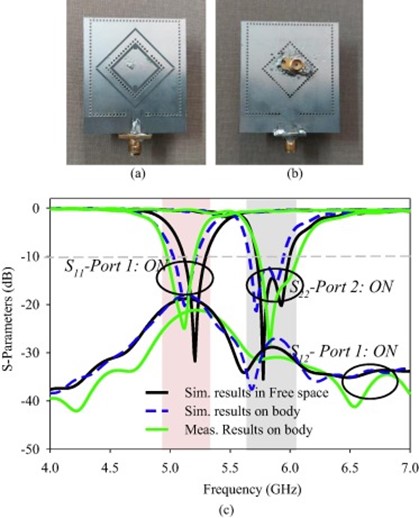
With the recent advancements in modern wireless body area network (WBAN) communication, the demand for compact low-profile wireless computing devices has witnessed a vast increase. Consequently, the antennas which play a critical role in this network are developed with different polarization in distinct frequency bands so as to maintain better reliability of communication links. Dr Divya Chaturvedi, Assistant Professor, Department of Electronics and Communication Engineering, has published a paper titled, “A Dual-Band Dual-Polarized SIW Cavity-Backed Antenna-Duplexer for Off-body Communication” as first author in the Q1 Journal AEJ – Alexandria Engineering Journal having an impact factor of 6.77. The paper discusses the self-duplexing antennas, offering two channels for concurrent transmission and reception, leading to a simple and compact transceiver.
Abstract
A novel dual-band, dual-polarized antenna-duplexer scheme is intended to be used for WLAN 802.11a and ISM band applications using Substrate Integrated Waveguide (SIW) Technology. The antenna consists of two planar SIW cavities of different dimensions where a smaller sized diamond- shaped cavity is inserted inside the larger rectangular cavity to share the common aperture area. The diamond-ring shaped slots are etched in each cavity for radiation. The larger diamond ring slot is excited with a microstrip feedline to operate at 5.2 GHz while the smaller slot is excited with a coaxial probe to operate at 5.8 GHz. The antenna produces linear polarization at 5.2 GHz (5.1–5.3 GHz) due to the merging of TE 110 and TE 120 cavity modes while circular polarization around 5.8 GHz due to orthogonally excited TM100 and TM010 modes (5.68–5.95 GHz). The slots are excited in an orthogonal fashion to maintain a better decoupling between the ports (i.e. –23 dB). The performance of the antenna has been verified in free space as well as in the vicinity of the human body. The antenna offers the gain of 6.2 dBi /6.6 dBi in free space and 5.8 dBi / 6.4 dBi on-body at lower-/ higher frequency-bands, respectively. Also, the specific absorption rate (SAR) is obtained < 0.245 W/Kg for 0.5 W input power averaged over 10 mW/g mass of the tissue. The proposed design is a low-profile, compact single-layered design, which is a suitable option for off-body communication.
Explanation of the research in layperson’s terms
- This antenna can operate in dual radio frequency bands at 5.2 GHz and 5.8 GHz respectively.
- The antenna can be used in the medical instrument to make it wire-free.
- The antenna is compact in size, thus can be accommodated in a small space.
- The antenna can operate simultaneously at both the frequency bands, thus at the same time it can help in forming links with another on-body antenna and makes the link with Wi-Fi.
- The antenna is validated in terms of Specific absorption rate, hence it is safe to use on the human body.
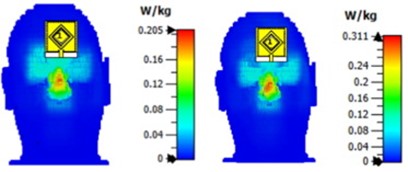
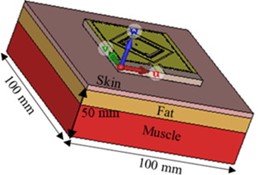
The paper further expounds on the social implication of this innovative research. Dr Chaturvedi explains that the antenna, being dual-band and dual-polarized, can function as a transceiver circuit. Due to different polarization, it can operate in both the frequency bands simultaneously without affecting the performance. In the first frequency band at 5.2 GHz, it can link with Wi-Fi and in the second frequency band at 5.8 GHz, it is able to communicate with antennas placed in other medical instruments which are used in the vicinity of the human body.
Collaborations
1. Dr Arvind Kumar, Assis. Professor, b Department of Electronics and Communication
Engineering, VNIT Nagpur, India
2. Dr Ayman A Althuwayb, Department of Electrical Engineering, College of Engineering,
Jouf University, Sakaka, Aljouf 72388, Saudi Arabia
- Published in Departmental News, ECE NEWS, News, Research News


